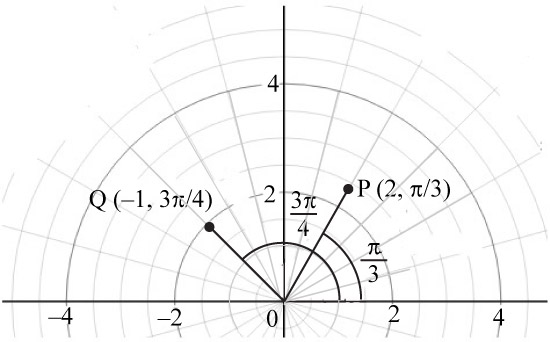
- (a) Explain the polar
coordinate system . - (b) Graph the points with polar coordinates (2, π/3) and (−1, 3π/4).
- (c) State the equations that relate the rectangular coordinates of a point to its polar coordinates.
- (d) Find rectangular coordinates for (2, π/3).
- (e) Find polar coordinates for P(−2, 2).
(a)
To describe: The polar coordinate system.
Explanation of Solution
The coordinate system
In polar coordinate system r shows the distance of the point and
In polar coordinate system take
In polar coordinate system negative r signifies that the polar coordinate
The below figure shows the polar coordinates

Figure (1)
In the above figure, the point P is r unit away adjoining with angle
(b)
To sketch: The graph of the polar coordinates.
Explanation of Solution
The below graph shows the polar coordinates

Figure (2)
In the above graph, point
(c)
To describe: The equations that relate the rectangular coordinates and polar coordinates of a point with each other.
Explanation of Solution
Use the equations
Use the equations
(d)
To find: The rectangular coordinate of the point.
Answer to Problem 1RCC
The rectangular coordinate of the point
Explanation of Solution
Given:
The value of polar coordinate is
Calculation:
Use the equations
The formula to calculate the x coordinate is,
Substitute 2 for r and
The value of the x coordinate is 1.
The formula to calculate the y coordinate is,
Substitute 2 for r and
The value of the y coordinate is
Thus, the rectangular coordinate of the point
(e)
To find: The polar coordinate of the point.
Answer to Problem 1RCC
The polar coordinate of the point
Explanation of Solution
Given:
The value of rectangular coordinate is
Calculation:
Use the equations
The formula to calculate the r is,
Substitute
The value of r is
The formula to calculate the value of
Substitute
The value of
Thus, the rectangular coordinate of the point
Want to see more full solutions like this?
Chapter 8 Solutions
PRECALCULUS LL + WEBASSIGN/COREQUISITE
- I need help in ensuring that I explain it propleryy in the simplifest way as possiblearrow_forwardI need help making sure that I explain this part accutartly.arrow_forwardPlease help me with this question as I want to know how can I perform the partial fraction decompostion on this alebgric equation to find the time-domain of y(t)arrow_forward
- Please help me with this question as I want to know how can I perform the partial fraction on this alebgric equation to find the time-domain of y(t)arrow_forwardEvaluate F³ - dr where ♬ = (4z, -4y, x), and C' is given by (t) = (sin(t), t, cos(t)), 0≤t≤ñ .arrow_forwardMid-Term Review Find the formula for (f + g)(x). f(x) = x² - 10x + 25 and g(x) = x² - 10x + 24 (f + g) (x) = [ 2 ]x² X + DELL Skip Sarrow_forward
- Calculus III May I please have some elaborations on Example 2 part a? Thank you.arrow_forward1. A bicyclist is riding their bike along the Chicago Lakefront Trail. The velocity (in feet per second) of the bicyclist is recorded below. Use (a) Simpson's Rule, and (b) the Trapezoidal Rule to estimate the total distance the bicyclist traveled during the 8-second period. t 0 2 4 6 8 V 10 15 12 10 16 2. Find the midpoint rule approximation for (a) n = 4 +5 x²dx using n subintervals. 1° 2 (b) n = 8 36 32 28 36 32 28 24 24 20 20 16 16 12 8- 4 1 2 3 4 5 6 12 8 4 1 2 3 4 5 6arrow_forward= 5 37 A 4 8 0.5 06 9arrow_forward
 Trigonometry (MindTap Course List)TrigonometryISBN:9781337278461Author:Ron LarsonPublisher:Cengage LearningAlgebra & Trigonometry with Analytic GeometryAlgebraISBN:9781133382119Author:SwokowskiPublisher:Cengage
Trigonometry (MindTap Course List)TrigonometryISBN:9781337278461Author:Ron LarsonPublisher:Cengage LearningAlgebra & Trigonometry with Analytic GeometryAlgebraISBN:9781133382119Author:SwokowskiPublisher:Cengage

